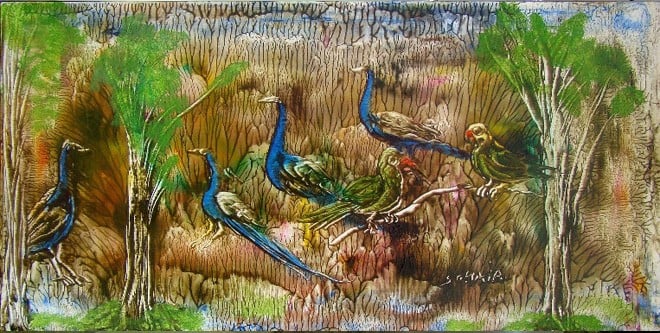

It is no surprise that Tassaduq Sohail is so old yet active and painting. But the most surprising aspect is that his worldview reflected in his work has not transformed with age or change of location (he has moved from London to Karachi).
Like many of his previous exhibitions, his most recent solo show Dream Encounters at the Hamail Art Galleries, Lahore (May 10-16, 2014) also has subjects, narratives and imagery that are not drastically different. Nor is the scale of these paintings unusual, as the artist has picked small surfaces and medium size canvases in order to express scenarios of a world that lies both within and outside.
In fact, his visual material and themes appear to be a means of negotiating the personal with the public and vice versa. Even though in recent works, one finds an inclination towards a specific technique (several paintings are created with dripping colours, resembling the effect of two wet surfaces joined and then separated immediately), these canvases include a set of images that shaped his aesthetics years ago. We see primordial landscapes with peacocks, parrots, elephants, fish, cockerels, occasional head of a donkey, along with bearded faces of men and figures of naked females.
This particular world conveys a truth about the artist’s vision, fascinations and limitations too. From an early stage of his career, Tassaduq has opted for this kind of pictorial language which, like words, has been manipulated in various combinations.Yet it is the impact of his paintings, with their seemingly sinister atmosphere that completes his narrative and makes him a distinct maker of images who is unmatched and without any follower.
A few traits of this pictorial republic from his canvases (since like Eden it seems like a free society) are about reverting to a basic and essential mode of existence. So no matter how hard you try, you are unable to find any sign of modern day life like cars, watches, televisions, electricity poles, roads, trains, aeroplanes or even houses. In fact what he has painted is purely based upon the raw and unaltered components of nature (men’s dresses are the only exception).
Although the solo exhibition is called Dream Encounters (one wonders who selected the title, the artist himself for the gallery), the works do not reflect an individual’s personal dreams. Instead, these amount to the construction of a realm that existed before or beyond our tangible world; which could be traced in collective memories, manifested through the form of folklore, fables and myths -- fantasy infused with actuality. In some of his paintings, suggestions of trees, leaves, animals and clouds correspond to our normal experience and perception but the artist has changed their proportion. Thus an elephant is similar in scale to a sparrow, or a parrot is equal in size to a half-clad woman.
Along with the modification reality through its scale and placement, which reminds of naïve art as well as some of the Indian miniature painting, Sohail’s works communicates a sense of timelessnes due to its constant amount/direction of light and the absence of shadows. This aspect of timelessness if analysed is a metaphoric representation of the history of Tassaduq Sohail’s art; thus like formal characteristics within the work, the art of Sohail is not subject to modification. An observation, which may sound odd or objectionable in the context of any other artist but, in the case of the 84 year-old painter, assumes a specific significance and certain relevance.
This is mainly because the strategies of image-making are devoid of any effects of the passage of time. Characters and entities in his work could be from any age or any area. Like in folk tales, one can associate with these pictures/scenes where nothing is happening, but the mere setting is enough to set our imagination on flight.
With his customary colour palette, distinct style of mark making, and unexpected formal solutions, his approach towards visual material is also important. Interestingly, his male figures are fully covered in clothes, while the women are rendered in nude. One can interpret this in simplistic terms if one believes in the notion of female form as the most adorable, beautiful and inspiring entity. A notion that has been in circulation long before Romanticism and after, but which conveniently forgets the works of artists such as Michelangelo who have explored the beauty of male body.
The difference of representation of male and female in Sohail’s work is not merely an attempt to express the idea of beauty. It may have a different connotation. As represented in his art women, like plants and animals, are in natural state. Much like beasts, birds and fish, which in a way are naked, women are also without any embellishment/burden of human cultural commodity. They emerge as pure as other entities and become a part of their surroundings. It is only the man, who is an alien, and has to hide his original/initial being under his layer of fabric.
In that sense the man, even though he looks like a religious or orthodox figure with his turban and beard, can be a symbol or substitute of the painter who -- despite his appreciation of flesh, attraction to beauty, and involvement with the uncanny; but because of his craft of adding images on tangible surfaces -- is an ultimate outsider. And remains so in the words of Polish poet, Czeslaw Milosz, "a strange guest in the kingdom of love".
This article was published in The News on Sunday May 25, 2014 with the title A very old man and a very old scene